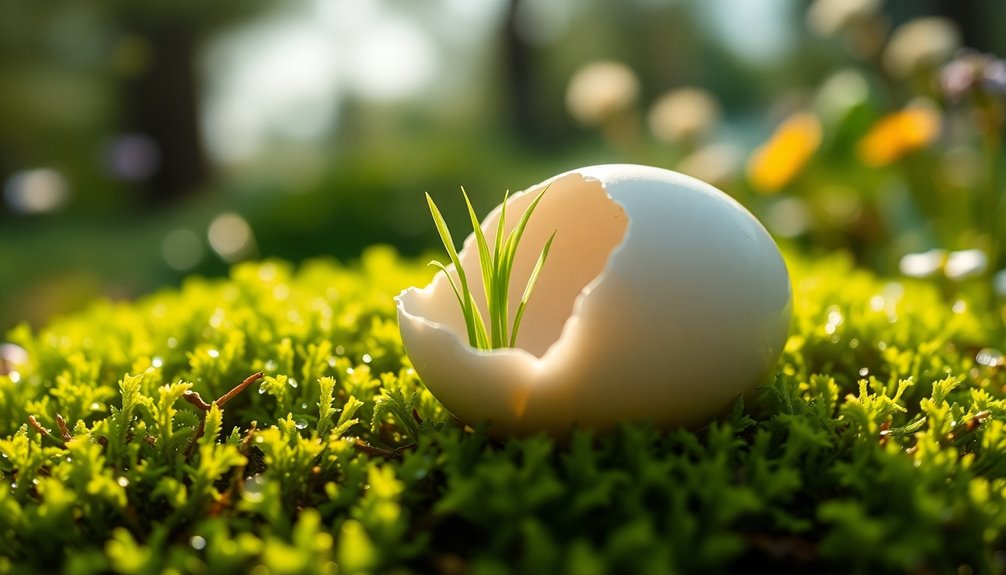A broken egg represents both fragility and the promise of potential. It highlights life's delicate balance between vulnerability and transformation. When you see a broken egg, think of it as a sign of new beginnings, whether it's a chance for personal growth or a call to let go of old beliefs. Different cultures connect broken eggs to rebirth and change, emphasizing their role in life's cycles. Each crack can symbolize opportunities for self-reflection and renewal. If you're curious about how these symbols show up in dreams or deeper meanings, there's more to explore!
Key Takeaways
- Broken eggs symbolize transformation and rebirth, representing the cycle of life and new beginnings across various cultures.
- They reflect fragility, emphasizing the balance between safety and vulnerability in personal experiences.
- The act of breaking can signify self-reflection, prompting individuals to reassess old beliefs and embrace change.
- In dreams, broken eggs often indicate emotional states and unresolved issues, highlighting fears of failure and missed opportunities.
- Overall, broken eggs serve as catalysts for personal growth, encouraging acceptance of life's imperfections and the exploration of new possibilities.
Symbolism of Eggs and Fragility

In the domain of symbolism, eggs represent potential and new beginnings, perfectly embodying fragility. They remind you of the delicate balance between safety and vulnerability inherent in life. The fragility of eggs highlights the care required to nurture potential, urging you to protect what's precious.
When you encounter broke eggs, it signifies transformation and change, revealing hidden talents and pushing you to confront your limitations for personal growth.
This symbolism is deeply rooted in various cultures, where broken eggs evoke themes of rebirth and renewal, reflecting the cyclical nature of life. It's a reminder that change is inevitable and often necessary for progress.
As you navigate your journey, consider how shattering old beliefs creates space for new experiences. Embracing this process can lead to profound self-discovery and the development of a richer, more fulfilling life.
In essence, eggs embody the potential that lies within each of us. They inspire you to recognize that even in vulnerability, there's strength and opportunity for growth.
The Act of Breaking

Breaking an egg symbolizes the moment when old beliefs and limitations shatter, making way for new possibilities. The act of breaking can represent a sudden change or revelation in your life, prompting a transformation that leads to personal growth and spiritual awakening.
It's in this pivotal moment that you might discover hidden talents and abilities you never knew you had. As you embrace the act of breaking, you encourage yourself to step out of your comfort zone.
This delicate balance between stasis and change is essential in your journey. Broken eggs often act as catalysts for self-reflection, allowing you to examine your emotional well-being and prompting important introspection.
Whether the egg is broken accidentally or intentionally, the context can greatly alter its interpretation. Each instance reveals deeper meanings related to your personal growth or disruption.
Additionally, the concept of Law of Attraction emphasizes that embracing change can attract positive outcomes in your life.
Cultural Perspectives on Broken Eggs

Exploring cultural perspectives on broken eggs reveals a rich tapestry of meanings and symbolism across various traditions. In Ancient Egypt, broken eggs symbolized rebirth, closely linked to the sun god Ra, reflecting beliefs in life cycles and renewal.
Similarly, in Christianity, eggs are tied to Easter, where broken eggs represent resurrection and new life, showcasing the emergence of life from death.
Chinese culture views broken eggs as omens of fertility and prosperity, often celebrating them to signify good fortune and new beginnings.
In African traditions, particularly among the Zulu, broken egg dreams serve as messages from ancestors, indicating disruptions in the life cycle and prompting reflection. This highlights the significance of broken eggs in understanding personal and communal transformations.
In various spiritual practices, such as Santeria, broken eggs play an essential role in rituals for cleansing and divination. Here, they symbolize the potential for transformation and renewal, showcasing their importance across cultures.
Environmental Context in Interpretation

When you break an egg, whether by accident or design, the context shapes its meaning considerably.
Factors like the egg's color and condition, as well as your environment, can influence your interpretation of the event.
Understanding these elements helps you grasp the deeper implications behind a seemingly simple act.
Accidental vs. Intentional Breaking
The distinction between accidental and intentional egg-breaking holds significant weight in interpreting their meanings, especially within different environmental contexts. Accidental breaks often signify unforeseen challenges and missed opportunities, reflecting the fragility of plans. In contrast, intentional breaks symbolize a conscious choice for transformation and personal growth.
| Type of Breaking | Symbolic Meaning |
|---|---|
| Accidental Breaking | Disruption in life patterns |
| Intentional Breaking | Deliberate release of old habits |
| Environmental Context | Influences emotional implications |
When you consider the environment in which an egg is broken, the meaning can shift dramatically. In natural settings, eggs broken may represent a part of the life cycle, while those broken in human contexts often carry heavier emotional implications. Cultural interpretations further complicate this dynamic; different societies may attribute varying meanings to accidental versus intentional breaks based on their unique beliefs. Understanding these nuances allows you to grasp the deeper significance behind the fragile shell of an egg and its potential for transformation in your life.
Environmental Influences on Meaning
Environmental context plays an essential role in shaping the meaning of broken eggs, influencing how you interpret these events. The surrounding environment can alter the symbolism associated with fragility and potential, depending on various factors.
Consider these environmental influences:
- Setting: Broken eggs in nature signify life cycles, while those in human environments suggest intervention.
- Method of Breaking: Accidental breaks might evoke different emotions than intentional ones, which often signify transformation.
- Cultural Beliefs: Different cultures imbue broken eggs with distinct meanings based on context, affecting your interpretation.
- Personal Circumstances: Your own experiences can change how you perceive the significance of broken eggs, highlighting their emotional weight.
- Atmosphere: The feelings present in a situation can amplify or diminish the symbolism of broken eggs.
Ultimately, the interpretation of broken eggs is deeply intertwined with environmental context. Recognizing the interplay between life cycles, emotions, and personal circumstances allows you to appreciate the richness of these symbols and their potential for transformation in your life.
Color and Condition Significance
Colors and conditions of broken eggs can greatly shape their symbolism and meaning. The color and condition significance is essential in interpreting broken egg dreams. For instance, white eggs often symbolize purity and clarity, suggesting a fresh start or emotional growth. On the other hand, brown eggs may represent earthiness, grounding you in the cycle of life. Fresh broken eggs might indicate new phases, while rotten ones signify decay and missed opportunities.
In spiritual practices, the specific colors and conditions of broken eggs carry valuable insights, reflecting your current life circumstances. Accidental breakages in your home can imply different meanings compared to those occurring in nature. In wild settings, broken eggs signify the natural cycle of life, emphasizing the acceptance of change.
Understanding the context of the breakage—like the environment and method—further enriches its interpretation. This highlights the importance of situational factors in grasping the deeper meanings behind these symbols.
Psychological Insights and Dream Analysis

When you dream of a broken egg, it can reveal a lot about your emotional state and subconscious fears.
By exploring these dreams, you can uncover unresolved issues and missed opportunities in your life.
Understanding the techniques of dream interpretation will help you reflect on these insights and guide your personal growth.
Dream Interpretation Techniques
Dream interpretation techniques often explore the psychological insights that can reveal the complexities of our subconscious. When you dream of broken eggs, it can expose deep-rooted fears and unresolved emotional issues.
To make sense of these dreams, consider the following techniques:
- Personal Context: Reflect on your current life circumstances; they shape your interpretations.
- Symbolism: Recognize that a broken egg often signifies missed opportunities or fears of failure.
- Jungian Analysis: View the egg as a representation of self, indicating a journey toward self-discovery and personal growth. This journey may involve addressing emotional dysregulation, which is a key characteristic of Borderline Personality Disorder (BPD). Understanding the Narcissist-Borderline dynamic can also provide insights into these emotional struggles. Additionally, this process may involve navigating intense interpersonal relationships that can arise during significant life transitions. Relationships with individuals exhibiting narcissistic behavior can further complicate these emotional challenges.
- Freudian Lens: Understand that these dreams may relate to sexual frustrations or intimacy concerns.
- Gestalt Approach: Consider your unique associations with the egg; your feelings about it can guide your understanding.
- Additionally, dreams of broken eggs may signify the need for clear communication in relationships, reflecting unresolved emotional conflicts.
Emotional States Reflection
Emotional states during sleep play an essential role in shaping the meanings of your dreams, especially when it comes to symbols like broken eggs. When you dream of a broken egg, it often reflects your subconscious anxieties and feelings of vulnerability. These dreams can signify your worries about failure or loss in your waking life, urging you to confront unresolved issues that mirror your emotional turmoil.
Carl Jung viewed eggs as symbols of self and potential, suggesting that dreaming of broken eggs may indicate a transformative journey toward self-discovery and personal growth. In contrast, Freud associated broken eggs with sexuality and fertility concerns, hinting at underlying sexual frustrations or reproductive anxieties.
The emotional states you experience during these dreams amplify their meanings, emphasizing the need for personal reflection. If you feel a strong sense of vulnerability or distress while dreaming of a broken egg, it's vital to acknowledge these feelings.
Subconscious Fears Exploration
Acknowledging the emotional states tied to broken egg dreams naturally leads to exploring the subconscious fears they reveal. These dreams often symbolize deeper anxieties related to failure and unfulfilled potential.
As you navigate these dreams, consider how they relate to your personal associations and emotional turmoil. Here are some common fears that might surface:
- Fear of failure and missed opportunities
- Anxiety about personal transformation and growth
- Concerns regarding individuality and self-discovery
- Underlying issues of sexuality and fertility
- Emotional struggles with unresolved issues
Carl Jung saw broken eggs as symbols of the self, indicating that confronting these fears can lead to spiritual growth and individuation. Understanding the impact of gaslighting tactics can also aid in recognizing how these fears manifest in your dreams and relationships.
Similarly, Freud's interpretations highlight anxieties about sexual frustrations. Gestalt psychology emphasizes that these dreams reflect fragments of your personality, urging you to address emotional turmoil and embrace necessary changes.
Additionally, understanding the impact of narcissistic abuse can provide insight into how unresolved emotional struggles influence your dreams and overall mental health.
Ultimately, broken egg dreams challenge you to face your subconscious fears head-on, revealing pathways to transformation and self-discovery.
Embracing these insights can catalyze profound personal growth, turning your fears into opportunities for healing and empowerment.
Spiritual Messages From Broken Eggs

Transformation often comes from unexpected places, and broken eggs serve as compelling symbols of this journey. When you encounter a broken egg, it's crucial to recognize its spiritual messages. These fragments reflect your readiness for transformation, encouraging you to release old patterns and beliefs that no longer serve you.
In various spiritual practices, such as Santeria and Oomancy, broken eggs are utilized for cleansing rituals, emphasizing their role in renewal and fertility. The act of breaking an egg symbolizes shattering limitations, inviting you to uncover hidden potentials. It's a reminder that vulnerability can lead to profound growth.
Embracing these messages from the universe allows for self-reflection and emotional healing, significant steps on your personal journey. Each broken egg carries unique symbolism based on your circumstances and cultural perspectives, reminding you of life's cycles of creation and destruction.
Common Scenarios in Dreaming

Dreams often serve as windows into our subconscious, revealing the hidden fears and desires that shape our waking lives. When you dream of a broken egg, it might signify a deep-seated fear of failure or missed opportunities. The context of how the egg is broken can provide essential insights into your emotional state.
Consider these common scenarios:
- Dropping an egg: This often reflects anxieties about your current path in life, highlighting feelings of vulnerability. It can also mirror the importance of maintaining involvement in your children's lives during challenging times.
- Cracking an egg: This might reveal hidden truths or potentials that you've been hesitant to acknowledge.
- Smashing an egg: This scenario represents destructive behaviors or the loss of potential, emphasizing feelings of frustration.
- Encountering multiple broken eggs: This can symbolize a significant need for personal transformation, urging you to confront your emotions.
- Intentional versus accidental breaks: The difference can indicate varying degrees of control over your circumstances.
Additionally, the emotional impact of such dreams can mirror the trust issues often experienced by children of unfaithful parents, emphasizing the importance of addressing underlying fears.
The Role of Color and Condition

Color and condition play a significant role in interpreting the symbolism of a broken egg. The color of the eggshell can influence your perception; for example, white eggs often symbolize purity and clarity, while brown eggs represent earthiness and groundedness.
When you encounter an egg, its condition is essential—fresh eggs brim with potential and energy, while cracked or broken eggs highlight vulnerability and the need for change.
In different cultural contexts, these interpretations shift. White eggs might signify new beginnings, while brown eggs could be tied to fertility and prosperity. The symbolism doesn't stop there; vibrant colors can evoke positive emotional states, whereas dull or damaged shells indicate emotional distress or unfulfilled potential.
Consider the environment too; wild bird eggs found broken in nature reflect a natural life cycle, suggesting acceptance. In contrast, broken eggs in a domestic setting might carry more negative connotations, reflecting loss or disappointment.
Transformative Lessons From Broken Eggs

Encountering a broken egg can stir profound realizations about your own life and growth. Each crack represents a transformative opportunity, urging you to break free from old beliefs and limitations. Embrace the vulnerability that comes with these moments; it's an essential part of your journey toward personal growth.
Here are some lessons that broken eggs can teach you:
- Catalysts for Change: They encourage significant change in your life.
- Embrace Vulnerability: A reminder that vulnerability is a strength, not a weakness.
- Self-Reflection: They prompt deep self-reflection, allowing you to confront unresolved issues.
- New Ideas: Broken eggs symbolize the birth of new ideas and possibilities.
- Emotional Well-Being: They highlight the importance of reassessing your emotional well-being.
In various cultures, broken eggs signify disruption, marking the duality of destruction and creation. By recognizing these spiritual messages, you're inspired to step out of your comfort zone.
Frequently Asked Questions
What Does Breaking an Egg Symbolize?
When you break an egg, it symbolizes the disruption of your old beliefs and limitations.
This act often represents vulnerability but also the potential for growth and transformation.
You might find that it signifies a moment of revelation, prompting you to reflect on your current path.
As you embrace this change, you recognize the duality of destruction and creation, ultimately leading you to new beginnings and opportunities for personal development.
What Does the Cracking of the Egg Symbolize?
When you think about the cracking of an egg, it symbolizes a significant transformation or revelation in your life.
It often represents the discomfort that comes with growth, reminding you that change is necessary for personal development. You might see it as a call to confront vulnerabilities and fears, urging you to explore hidden potentials.
Ultimately, it represents a pivotal moment where new opportunities arise, leading to fresh beginnings and deeper insights.
What Does Egg Symbolize Spiritually?
When you think of an egg, picture a delicate treasure, cradling life within its fragile shell.
Spiritually, eggs symbolize potential and transformation. They embody the promise of new beginnings, inviting you to explore hidden talents and growth.
In various cultures, their essence reflects rebirth and renewal, urging you to embrace change and introspection.
Just like the egg, you're reminded that within vulnerability lies the power to evolve and flourish.
What Does "Cracked Egg" Mean?
When you encounter the concept of a "cracked egg," it often reflects the idea of revealing hidden truths or potentials.
It can symbolize vulnerability and the fear of failure, urging you to look inward and confront any unresolved emotions.
This imagery suggests that breaking through old limitations might be necessary for personal growth.
Embracing the transformation that comes from acknowledging these feelings can pave the way for new beginnings and deeper self-understanding.
Conclusion
In life, like a broken egg, you can find beauty in fragility. Imagine a bird struggling to break free from its shell; it's a messy process, but that struggle leads to flight. Embracing the potential that comes from vulnerability allows you to grow. So, when you face challenges, remember that breaking can lead to new beginnings. Just as the cracked egg nurtures a new life, your own struggles might just be the catalyst for transformation.











